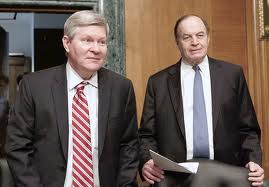All eyes are on the House side of Capitol Hill today in anticipation of the Republicans' grand unveiling of their American Energy & Infrastructure Jobs Act at 3:00 p.m. But last night, some enduring questions about the Senate's transportation bill finally got some answers. Senators Tim Johnson and Richard Shelby, respectively the chairman and ranking member of the Senate Banking Committee, released a summary of the Federal Public Transportation Act of 2012, providing a preliminary guide to how the Senate will treat transit [PDF].

Johnson and Shelby's bill will serve as the transit component of the Senate's two-year reauthorization bill, MAP-21, which passed the Environment and Public Works Committee with bipartisan support last month.
In one significant policy shift, the bill would enable transit authorities to use federal funds to pay for some of their operating expenses during "periods of high unemployment." Generally, use of federal transit funds is restricted exclusively to system expansion and maintenance, but transit agencies across the country are slashing service, raising fares and laying off workers due to the effects of the economic downturn. This bill would offer them some much-needed relief.
The bill reauthorizes close to $21 billion in transit funding over two years, protecting many popular programs and expanding new ones. The reception so far has been generally positive. Jesse Prentice-Dunn of the Sierra Club told Streetsblog that he is "encouraged" and that "the Banking Committee title appears to be a step forward for transit."
Among the more encouraging points listed in the summary, the new bill:
- Protects funding to the Job Access and Reverse Commute (JARC) program, which has been a priority since Barack Obama's first presidential campaign.
- Creates a new pilot program to support transit-oriented development with planning grants.
- Streamlines the New Starts program, eliminating duplicative steps and allowing smaller projects ($100 million or less) to complete an expedited review process.
- Expands the Rail Modernization program to include "high-intensity bus" networks, renaming it the State of Good Repair Grant program.
One aspect of the State of Good Repair program would reduce the incentive for states to overbuild carpool lanes. When calculating the size of a high-intensity bus network, "the new proposal no longer recognizes highway high occupancy vehicle lanes as eligible... if they are not reserved for the sole use of public transportation vehicles." This does not forbid SOGR grants from being used on HOV lanes, but it keeps HOV-heavy bus systems from looking larger on paper than they are in real life, and thereby grabbing a disproportionate share of transit funds for what is essentially a highway project.
The bill is also light on the program consolidation that had been so prevalent in the House and Senate's highway bills. Two programs aimed at improving mobility for senior citizens and the disabled will be merged, but it does not appear that there will be a corresponding cut to the programs' funding.
The bill will be marked up in committee on Thursday at 10 a.m.





